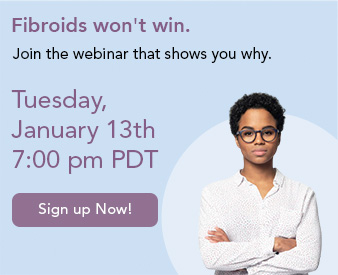Early Signs of Fibroids
WebMD states: Fibroids affect up to 80% of women before the age of 50. Uterine fibroid usually is benign and asymptomatic in the early stages. Many women are not even aware that they have fibroids. Early signs of fibroids may be easy to miss. However, when uterine fibroids grow large enough, they can cause symptoms which run the range from simply annoying to negatively impacting the quality of life. Often, the type and severity of the symptom depend on the size and type of fibroid, determined by where in the uterus they are located.
In women who have symptoms, the most common symptoms of uterine fibroids include:
- Heavy or excessive menstrual bleeding
- Prolonged menstrual periods—seven days or more of bleeding
- Pain during sex
- Pelvic pain
- Enlarged uterus
- Weight gain
- Infertility
- Frequent urination
- Difficulty emptying your bladder
- Constipation
- Backache or leg pain
8 Fibroids Symptoms
Heavy painful periods are the most common signs associated with fibroids. A heavy period is classified by needed to change a tampon or sanitary towel on an hourly basis for more than a couple of consecutive hours. This heavy bleeding is often accompanied by severe cramping and can lead to anemia. Other symptoms include a swollen or distended abdomen, a feeling of pressure in the stomach area, and a frequent need to urinate. In some cases, fibroids can lead to fertility issues including difficult pregnancies, increased chances of needing a cesarean delivery, as well as problems conceiving naturally. Here are some early signs of fibroids:
1. Enlarged Uterus
Fibroids can cause swelling in the abdomen, making your stomach large and distended. Not only can this cause issues with your appearance, but it can make it difficult to find clothing that fits and hurt your self-image. No one wants to appear overweight, especially when it’s due to a medical condition that can be treated fairly easily.
2. Pelvic Pain
Even though usually benign, a uterine fibroid is essentially a tumor-like overgrowth of abnormal tissue. It is little wonder then that having fibroids in and on your uterus can cause symptoms such as a feeling of fullness or bloating. Submucosal fibroids, in particular, can give a feeling of heaviness in the uterus. Fibroids can also cause generalized pain as they take up space meant for your uterus or other organs. Acute pain is rare but can happen if a fibroid outgrows its blood supply or significantly impedes the proper function of other organs.
3. Heavy Bleeding
This is a symptom which is most common with submucosal fibroids, which grow on the interior of the uterus, and the intramural fibroids which grow embedded in the muscular uterine wall. Women who suffer heavy periods know how trying annoying that time of the month can be. At its extreme, this symptom can drastically impact someone’s quality of life.
Beyond the practical considerations involved in the management of heavy flow and passage of clots, long term heavy bleeding can lead to anemia related exhaustion and other difficulties. Fibroids can also be a factor if you have painful periods, as intramural fibroids can make cramps much more intense by interfering with the proper function of the uterine muscle.
4. Weight Gain
You’ve put on pounds. Maybe developed a pooch you can’t get rid of. Could it be fibroids?
5. Painful Sex
There are many reasons a woman might experience pain during intercourse, but did you know that uterine fibroids could be a contributing factor? Submucosal and intramural fibroids, in particular, interfere with the normal operation of the uterus, pulling it out of shape and making any contractions or pressure painful. This can cause difficulties during sex, including bleeding if the fibroids are located near the cervix. The imbalance of hormones which fibroids cause can also have a negative effect on a woman’s libido, lowering desire and making intercourse less enjoyable. Sexual symptoms can be especially telling if you have never before had a problem with intercourse, but have recently started to experience a decrease in desire, pain, or bleeding. If you do experience pain or bleeding during intercourse, you should seek out the advice of a doctor right away.
6. Infertility
Untreated fibroids can make successful pregnancy challenging. Pregnancy should be a happy and exciting time in a woman’s life. Fibroids can cause complications throughout pregnancy, resulting in additional visits to the doctor, health complications for the mother and child, and a six-times greater chance of needing an emergency cesarean section.
A further complication includes infertility. When left untreated, fibroids can take up valuable real estate in the womb needed by a growing fetus, making it difficult or even impossible for a woman to conceive or maintain a pregnancy.
7. Back and Leg Pain
Back and leg pain is most common with Subserosal uterine fibroids, which grow on the outside of the uterus. If the fibroid is located on the back of the uterus, it is very close to the spinal column. If it becomes large enough it can press on or pinch the nerves in that area, causing fibroid pain. It can also cause sciatica as the fibroid presses against the sciatic nerve and sends pain down the back of the legs.
8. Frequent Urination or Constipation
Urinary incontinence is sometimes a sensitive subject, but have you considered that there may be factors at work beyond a lack of bladder control? If a uterine fibroid grows on the top of the uterus, it shares pelvic space with the bladder. This restricts the size available to the bladder, causing the need to go more often as well as contributing to urinary incontinence. At its worst, obstruction of the bladder and urinary tract can also lead to urinary tract infections (UTIs) and blood in the urine. Similarly, if the fibroid is located near the colon, it can obstruct normal bowel movement and lead to constipation as well as the painful passage of stools. If you are experiencing frequent UTIs, constipation, or discover blood in your urine or stools, promptly seek medical care.
Can Fibroids cause Varicose Veins?
Large fibroids can make the uterus big, leading to lower back pain or pelvic discomfort. Some women with fibroids experience a dull ache in their thighs or develop varicose veins in their legs. This can happen when fibroids become so large that they begin to press on nerves and blood vessels that extend to the legs, causing immense pain and discomfort in the legs. Results and experiences differ from woman to woman; however, it is important to note that if one experiences a sudden change in cycle, pain measure, or if there is a presence of abnormal symptoms, consulting a physician or Ob-gyn is advisable.
Can Fibroids Cause Back Pain?
There are multiple areas of the uterus where fibroids can be located. Intermural fibroids are located in the wall of the uterus, submucosal fibroids are located in the inside lining of the uterus, and subserosal fibroids are located in the outside lining of the uterus. Only subserosal fibroids can cause back pain, if they are large and protrude from the back of the uterus into the spine. On the other hand, submucosal fibroids bulge inwards towards the uterine cavity, and thus are unlikely to cause back pain.
Women typically undergo an ultrasound at their gynecologist’s office to visualize the uterus for fibroid tumors. Ultrasound, however, does not show other underlying diseases or all the existing fibroids, particularly their positions. Some doctors will suggest MRI to reveal if the fibroid is pressing against the spine, and rule out the possibility of other causes of back pain. Finding the appropriate treatment is key to getting relief from back pain and fibroid symptoms. For more information on the types of fibroids and associated symptoms please visit this article.
Do you have symptoms for fibroids?
If you are showing signs of fibroid symptoms and think you have fibroids, schedule an appointment for a professional diagnosis. One of our fibroid surgeons will talk to you about your symptoms and perform a pelvic exam. We may order further testing including an imaging procedure such as an ultrasound. If fibroids are diagnosed we will discuss the best fibroid treatment for you. Here at the Fibroid Treatment Collective, we offer free consultationsin-office or over the phone. Feel free to contact us for more information. To learn more about fibroids, visit our homepage.
Hope said NO to hysterectomy. YES to non-surgical embolization.
The worst thing about having fibroids was feeling like there was an alien inside of me. I had such horrible cramps. I had a feeling of heaviness, a feeling of being totally out of control. It was devastating to my social life and to my professional life …


